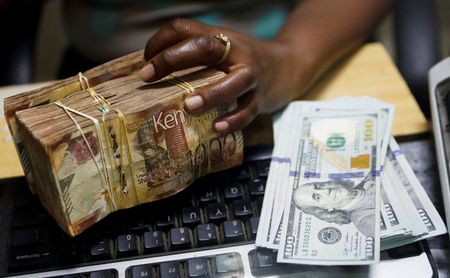By Amanda Cooper
LONDON (Reuters) -The dollar staged a broad retreat on Thursday, as investor gloom over the lack of any real progress towards defusing the U.S./China trade war reasserted itself following a brief interlude of optimism the previous day.
U.S. assets including the dollar rallied sharply on Wednesday after U.S. President Donald Trump backed down from threats to fire the head of the Federal Reserve and appeared to soften his stance on China.
Treasury Secretary Scott Bessent said separately that the current de facto embargo on U.S.-China trade was unsustainable, while cautioning that the U.S. would not move first in lowering its levies of more than 100% on Chinese goods.
By Thursday, those dollar gains had unravelled. China said there had been no negotiations on the economy and trade and it urged the U.S. to lift all unilateral tariff measures if it really wished to resolve the issue, leaving investors roughly where they were earlier in the week in terms of clarity.
The yen led the charge higher, leaving the dollar down 0.75% on the day at 142.39, but still above the 140-mark breached last week.
“There were hopes of a thaw in the U.S.-driven trade dispute with absolutely everyone,” Trade Nation strategist David Morrison said.
“(Trump) softened his tone towards China, calling on them to come and negotiate. But it turns out it takes two to tango, and for now, the Chinese leadership has decided to let the Trump administration stew in its own mess,” he added.
The dollar has been the biggest casualty of Trump’s on-off tariffs, dropping by 4.8% in April so far alone, which would mark its largest monthly decline since November 2022.
Investors had been shaken over the past few days when Trump made a series of verbal attacks on Fed Chair Jerome Powell over his reluctance to cut interest rates until the data justified such a move.
Such has been the investor pullback from the dollar that it is currently on course for its worst start to the year against a basket of currencies since the 1970s, according to LSEG data.
Jan Hatzuis, who is chief economist at Goldman Sachs, believes the dollar has a lot further to fall.
“A decision by non-U.S. investors to reduce their U.S. exposure would thus almost certainly result in significant dollar depreciation,” Hatzuis wrote in the Financial Times on Thursday.
“In fact, even reluctance by non-U.S. investors to add to their U.S. portfolios will probably weigh on the dollar,” he said.
The Swiss franc, which is around its strongest against the dollar in more than a decade thanks to hefty safe-haven flows this month, rose, leaving the U.S. currency down 0.6% on the day at 0.8251 francs.
The pound rose 0.5% to $1.332. UK finance minister Rachel Reeves said on Thursday she was “confident” Britain could reach a trade deal with the United States.
Bitcoin tracked the dollar lower, falling 1.2% on the day to $92,476. Meanwhile, Trump’s meme coin surged 33% overnight after the online promotion of a gala dinner with the president for the top 220 buyers of the $TRUMP coin. It is still only worth roughly a quarter of what it was at its launch in January.
(Reporting by Tom Westbrook; Editing Jamie Freed and Kate Mayberry, Kirsten Donovan)










